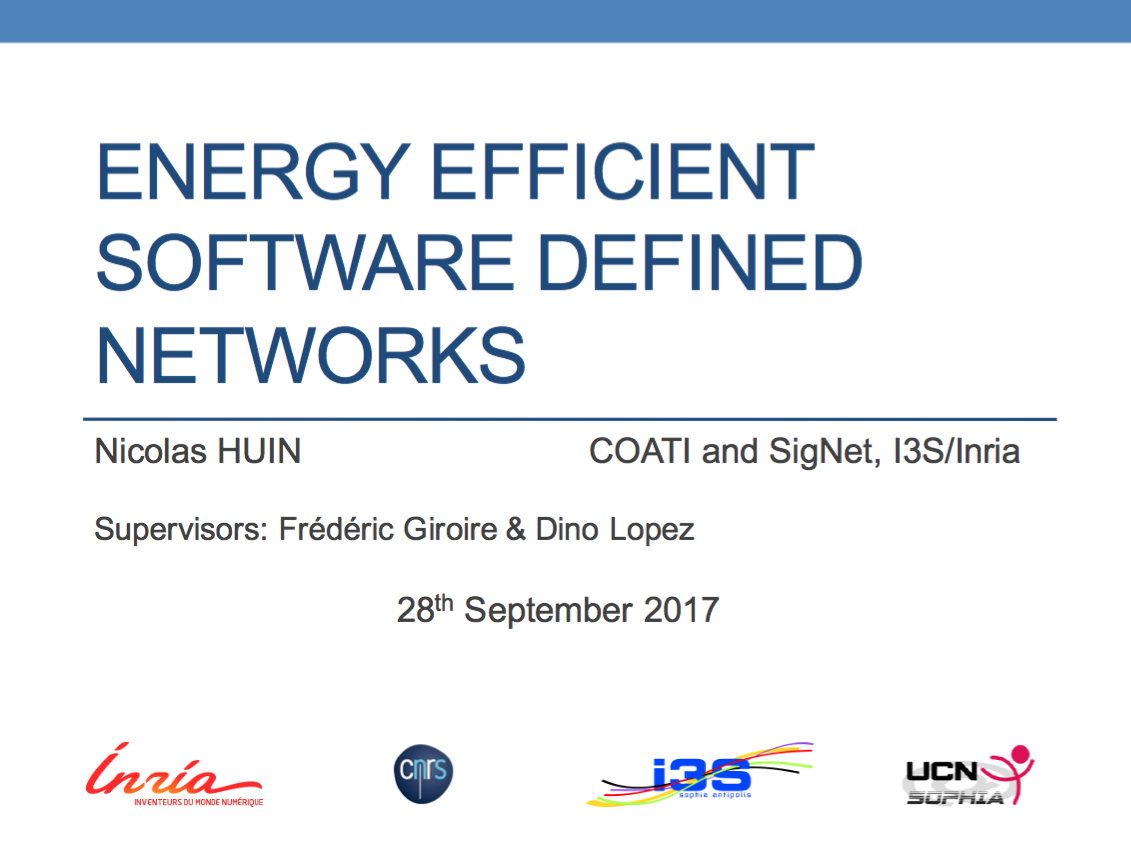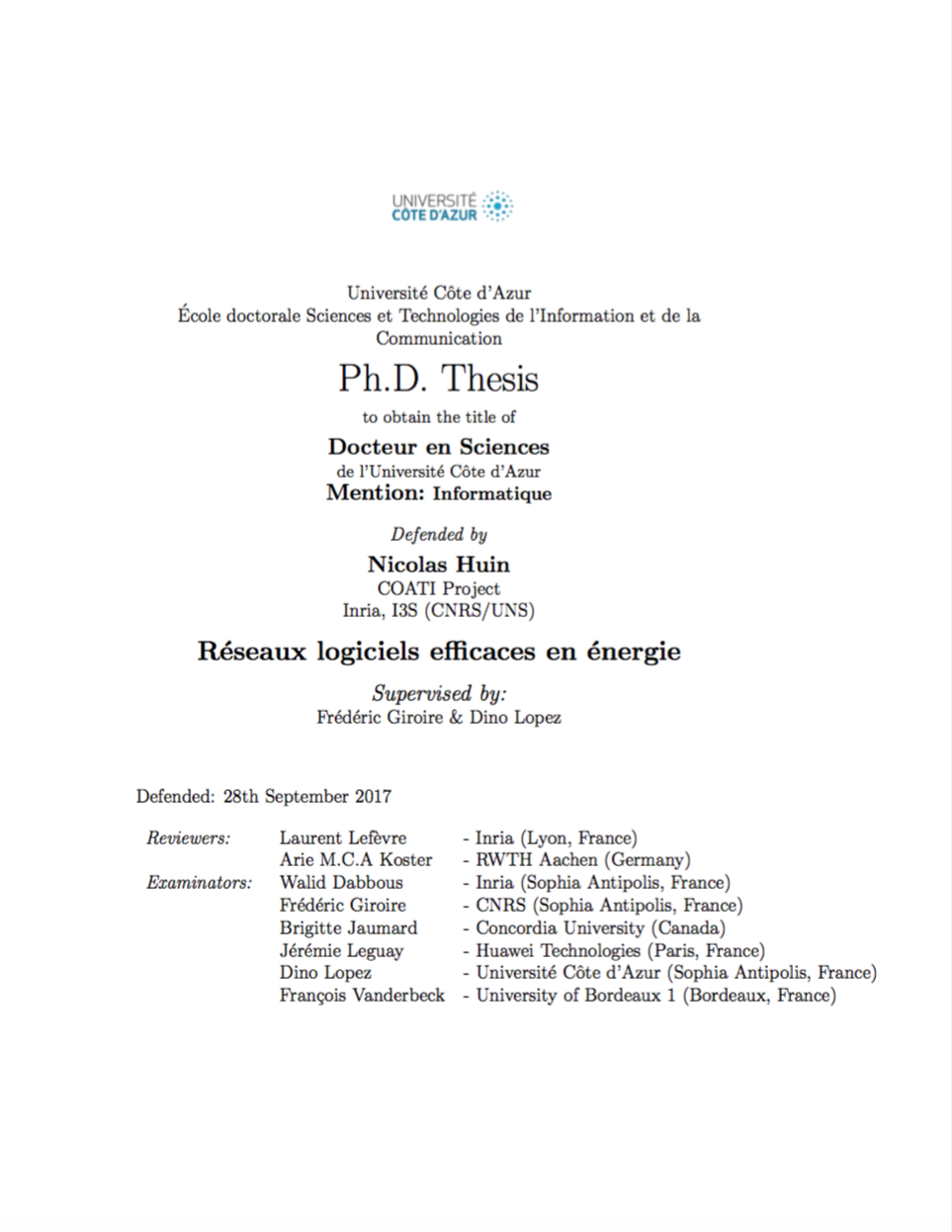
Manuscript (en français)

| Rapporteurs : | Laurent LEFEVRE | Inria (Lyon, France) |
| Arie M.C.A. KOSTER | RWTH Aachen (Germany) | |
| Examinateurs : | ||
| Walid DABBOUS | Inria (Sophia Antipolis, France) | |
| Frédéric GIROIRE | CNRS (Sophia Antipolis, France) | |
| Brigitte JAUMARD | Concordia University (Canada) | |
| Jérémie LEGUAY | Huawei Technologies (Paris, France) | |
| Dino LOPEZ | Université Côte d’Azur (Sophia Antipolis, France) | |
| Francois VANDERBECK | University of Bordeaux 1 (Bordeaux, France) |
Au cours des dernières années, la croissance des architectures de réseaux de télécommunication a rapidement augmenté pour suivre un trafic en plein essor. En outre, leur consommation d'énergie est devenue un enjeu important, tant pour son impact économique qu'écologique. De multiples approches ont été proposées pour la réduire. Dans cette thèse, nous nous concentrons sur l'approche Energy Aware Routing (EAR) qui consiste à fournir un routage valide tout en diminuant le nombre d'équipements réseau actifs.
Cependant, les réseaux actuels ne sont pas adaptés au déploiement de politiques vertes globales en raison de leur gestion distribuée et de la nature fermée des périphériques réseau actuels. Les paradigmes de Software Defined Network (SDN) et de Network Function Virtualization (NFV) promettent de faciliter le déploiement de politiques vertes. En effet, le premier sépare le plan de contrôle et de données et offre donc une gestion centralisée du réseau. Le second propose de découpler le logiciel et le matériel des fonctions réseau et permet une plus grande flexibilité dans la création et la gestion des services réseau.
Dans cette thèse, nous nous concentrons sur les défis posés par ces paradigmes pour le déploiement de politiques EAR. Nous consacrons les deux premières parties aux SDNs. Nous étudions d'abord les contraintes de taille de table de routage causées par la complexité accrue des règles, puis le déploiement progressif de périphériques SDN dans un réseau actuel. Nous concentrons notre attention sur NFV dans la dernière partie, et plus particulièrement nous étudions les chaînes de fonctions de services.
In the recent years, the growth of the architecture of telecommunication networks has been quickly increasing to keep up with a booming traffic. Moreover, the energy consumption of these infrastructures is becoming a growing issue, both for its economic and ecological impact. Multiple approaches were proposed to reduce the networks' power consumption such as decreasing the number of active elements. Indeed, networks are designed to handle high traffic, e.g., during the day, but are over-provisioned during the night. In this thesis, we focus on disabling links and routers inside the network while keeping a valid routing. This approach is known as Energy Aware Routing (EAR).
However current networks are not adapted to support the deployment of network-wide green policies due to their distributed management and the black-box nature of current network devices. The SDN and NFV paradigms bear the promise of bringing green policies to reality. The first one decouples the control and data plane and thus enable a centralized control of the network. The second one proposes to decouple the software and hardware of network functions and allows more flexibility in the creation and management of network services.
In this thesis, we focus on the challenges brought by these two paradigms for the deployment of EAR policies. We dedicated the first two parts to the SDN paradigm. We first study the forwarding table size constraints due to an increased complexity of rules. We then study the progressive deployment of SDN devices alongside legacy ones. We focus our attention on the NFV paradigm in the last part, and more particularly, we study the Service Function Chaining problem.